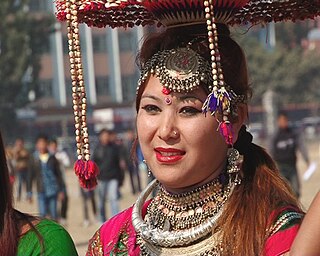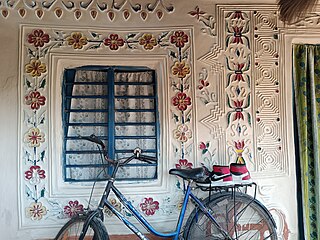Bihari languages are a group of the Indo-Aryan languages. The Bihari languages are mainly spoken in the Indian states of Bihar, Jharkhand, Uttar Pradesh, and West Bengal, and also in Nepal. The most widely spoken languages of the Bihari group are Bhojpuri, Magahi and Maithili.

The Tharu people are an ethnic group indigenous to the Terai in southern Nepal and northern India. They speak Tharu languages. They are recognized as an official nationality by the Government of Nepal. In the Indian Terai, they live foremost in Uttarakhand, Uttar Pradesh and Bihar. The Government of India recognizes the Tharu people as a scheduled Indian tribe.

Biratnagar is a metropolitan city in Nepal, which serves as the capital of Koshi Province. With a Metropolitan Urban Agglomeration population of 244,750 as per the 2021 census, it is the largest city and fastest growing city in the province and also the headquarters of Morang district. As per the preliminary report of 2022 Nepal census, Biratnagar Metropolitan has an estimated city population of 244,750 excluding the suburban areas which are now very well connected to the old town. It is the administrative center of the Greater Birat Development Area which incorporates the cities of Biratnagar and its suburbs and towns of-Itahari-Gothgau-Biratchowk-Dharan primarily located on the Koshi Highway in Eastern Nepal, with an estimated total urban agglomerated population of 804,300 people in 159,332 households including the town of Ithari. Biratnagar is located 399 km (248 mi) east of the capital, Kathmandu, and 6 km (3.7 mi) north of the bordering town of Jogbani in the Indian state of Bihar. It is one of the major entry point in Nepal for Businessmen as well as Tourists who come to visit Nepal for various purposes.

The Terai or Tarai is to a lowland region in parts of northern India and southern Nepal that lies to the south of the outer foothills of the Himalayas, the Sivalik Hills and north of the Indo-Gangetic Plain. This lowland belt is characterised by tall grasslands, scrub savannah, sal forests and clay rich swamps. In North India, the Terai spreads from the Yamuna River eastward across Haryana, Uttarakhand, Uttar Pradesh, Bihar and West Bengal. The Terai is part of the Terai-Duar savanna and grasslands ecoregion. Nepal's Terai stretches over 33,998.8 km2 (13,127.0 sq mi), about 23.1% of Nepal's land area, and lies at an elevation of between 67 and 300 m. The region comprises more than 50 wetlands. North of the Terai rises the Bhabar, a narrow but continuous belt of forest about 8–12 km (5.0–7.5 mi) wide.

Jhapa District is a district of Koshi Province in eastern Nepal named after a Rajbanshi Surjapuri language word "Jhapa", meaning "to cover" (verb). The 2021 Nepal Census, puts the total population of the district at 994,090. The total area of the district is 1,606 square kilometres.
{{Infobox settlement | type = District | name = Morang District | native_name = मोरङ जिल्ला | nickname = | native_name_lang = ne | motto = | image_skyline = Biratnagar Main Gate-1030.jpg | image_alt = | image_caption = Entrance to Biratnagar | image_map = Morang district locator.png | map_alt = | map_caption = | image_map1 = | mapsize1 = | map_alt1 = | map_caption1 = | coordinates = | coordinates_footnotes = | subdivision_type = Country | subdivision_name = Nepal | subdivision_type1 = Province | subdivision_name1 = Koshi Province | parts_type = Municipality | parts_style = coll | p1 = | p2 = | established_title = Established | established_date = 7th century circa | seat_type = Admin HQ. | seat = Biratnagar | leader_title = Head | leader_name = Mr. Naresh Prasad Pokhrel | leader_party = | leader_title1 = Deputy-Head | leader_name1 = Mr. Prakash Kumar Shah | leader_title2 = Parliamentary constituencies | leader_name2 = 6 | leader_title3 = Provincial constituencies | leader_name3 = 12 | government_footnotes = | government_type = Coordination committee | governing_body = DCC, Morang | area_footnotes = | area_total_km2 = 1855 | area_note = | area_rank = | elevation_footnotes = | elevation_m = | elevation_min_m = | elevation_max_m = | population_footnotes = | population_total = 1,147,187 | population_as_of = 2021 | population_density_km2 = auto | population_note = | population_rank = 1st | population_blank1_title = Households | population_blank1 = | blank_name_sec1 = Main Language(s) | blank_info_sec1 = Nepali, [[Limbu language|Limbu],Maithili, Tharu, Rajbanshi, | blank_name_sec2 = Minor Language(s) | blank_info_sec2 = Newar, Urdu,Magar,Tamang | timezone1 = NPT | utc_offset1 = +05:45 | postal_code_type = Postal Codes | postal_code = | area_code_type = Telephone Code | area_code = | website = www.ddcmorang.gov.np | footnotes = }}

Sunsari District is one of 14 districts in Koshi province of eastern Nepal. The district is located in the eastern part of the Outer Terai and covers an area of 1,257 km2 (485 sq mi). According to the 2011 Nepal census, the population was 753,328. The district headquarters is located in Inaruwa.

Udayapur District (Nepali: उदयपुर जिल्ला, is one of the 14 districts of Koshi Province in eastern Nepal. The district, with Triyuga as its district headquarters, covers an area of 2,063 km2 and in 2001 had a population of 287,689, in 2011 of 317,532, in 2021 of 342,773

Inaruwa is the headquarter of Sunsari district that lies in the Koshi province of Eastern Nepal. Inaruwa is a municipality since the time of Panchayat in the year 2047 BS. After 2015, it has been operating under a mayor-council form of government and is currently led by Mayor Kedar Bhandari. Spanning 77.92 square kilometers, the municipality is home to a population of nearly 75 thousand residents.
Madheshi people is a term used for several ethnic groups living in the central and eastern Terai region of Nepal. It has also been used as a political pejorative term by the Pahari people of Nepal to refer to non-pahari people with a non-Nepali language as their mother tongue, regardless of their place of birth or residence. The term Madheshi became a widely recognised name for Nepali citizens with an Indian cultural background only after 1990. Madheshi people comprise various cultural groups such as Hindu caste groups, Muslims, Marwaris, Brahmin and Dalit caste groups, ethnic groups like Maithils, Bhojpuri, Awadhi and Bajjika speaking people and indigenous people of the Terai. Many of these groups share cultural traditions, educational and family ties with people living south of the international border in Bihar, Uttar Pradesh and West Bengal. Tharu people and Pahari people living in the Terai do not consider themselves as Madheshi. In recent times, some politicians and journalists use the term for all Nepali citizens of the Terai.
Rangeli is a Municipality and rural market town in Morang District in the Koshi Zone of south-eastern Nepal. This municipality was formed merging existing four villages i.e.Amgachhi, Babiabirta, Darbesa and Rangeli itself since May 2014.
Limbuwan is an area of the Himalayan region historically made up of 10 Limbu kingdoms, now part of eastern Nepal. Limbuwan means "abode of the Limbus" or "Land of the Limbus". Limbuwan was incorporated into the Kingdom of Nepal by means of a collective Gorkha-Limbuwan Treaty with the kings of the ten Limbuwan kingdoms and their ministers.

The Tharu or Tharuhat languages are any of the Indo-Aryan languages spoken by the Tharu people of the Terai region in Nepal, and neighboring regions of Uttarakhand, Uttar Pradesh and Bihar in India.
Dhimal is a Sino-Tibetan language of Nepal spoken by about 20,000 people, mainly in the Terai of Koshi Province. There is an eastern and western dialect, which are separated by the Kankai River. Most people transcribe Dhimal into Devanagari and there are standard conventions for extra phonological distinctions.

Koshi Province is the autonomous easternmost province adopted on 20 September 2015 by Constitution of Nepal. The province is rich in natural resources, tourist attractions, recreational activities, and natural beauty. The province covers an area of 25,905 km2 (10,002 sq mi), about 17.5% of the country's total area. With the industrial city of Biratnagar as its capital, the province includes major eastern towns of Birtamod, Sundar Haraincha, Damak, Dharan, Itahari, Triyuga Municipality and Mechinagar, and the Mount Everest, Kangchenjunga and Ama Dablam. Koshi River, the largest river of the nation, forms the province's western boundary. Under the First-past-the-post voting system issued by the Constituency Delimitation Commission, Nepal, the province hosts 28 parliamentary seats and 56 provincial assembly seats.

Madhesh Province is a province of Nepal in the Terai region with an area of 9,661 km2 (3,730 sq mi) covering about 6.5% of the country's total area. It has a population of 6,126,288 as per the 2021 Nepal census, making it Nepal's most densely populated province and the smallest province by area. It borders Koshi Pradesh to the east and the north, Bagmati Province to the north, and India’s Bihar state to the south and the west. The border between Chitwan National Park and Parsa National Park acts as the provincial boundary in the west, and the Kosi River forms the provincial border in the east. The province includes eight districts, from Parsa in the west to Saptari in the east.

Ramdhuni is a municipality located in the Sunsari district, Koshi Province of Eastern Nepal. It was established in 2014. Ramdhuni previously known as Jhumka Bazar. It is approximately 356km far from Kathmandu. This town lies in the middle of two famous cities Itahari and Inaruwa. Mahendra highway passes right through the heart of the town. Chatara Canal originates all the way from Koshi River and flows through the town from north to south. This canal plays an important role in the agriculture of Sunsari and Morang district. Ramdhuni has a total area of 91.69 square kilometers. It has a population of 63,452 of which 29,820 are males and 29,820 are females living in 11,491 individual houses.
Kochila Tharu, also called Morangiya, Septari or Saptariya Tharu, Madhya-Purbiya Tharu, and Mid-Eastern Tharu, is a diverse group of language varieties in the Tharu group of the Indo-Aryan languages. The several names of the varieties refer to the regions where they dominate. It is one of the largest subgroupings of Tharu. It is spoken mainly in Nepal with approximately 250,000 speakers as of 2003. In addition to language, cultural markers around attire and customs connect individuals into the ethnic identity Kochila.

Rana Tharu is an ethnic group generally classified as part of the Tharu people of Nepal and India. They are living in Kailali and Kanchanpur Districts of the far western Nepali Terai and also in India, in Udham Singh Nagar district, Uttarakhand and Kheri district of Uttar Pradesh. As of 2001, Rana Tharu people were the largest of five scheduled tribes in Uttarakhand, with a population of 256,129 accounting for 33.4% of all scheduled tribes.

Mokha is a popular endemic art of Tharu community of eastern Nepal. The women, especially from Morang, Sunsari, Saptari, Siraha and Udayapur districts of eastern Nepal, decorate their mud walls with beautiful floral and geometric patterns including birds and animals.













